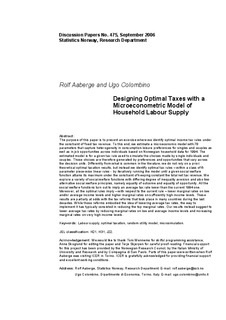| dc.contributor.author | Aaberge, Rolf | |
| dc.contributor.author | Colombino, Ugo | |
| dc.date.accessioned | 2011-11-14T21:32:47Z | |
| dc.date.available | 2011-11-14T21:32:47Z | |
| dc.date.issued | 2006 | |
| dc.identifier.issn | 1892-753x | |
| dc.identifier.uri | http://hdl.handle.net/11250/180589 | |
| dc.description.abstract | Abstract:
The purpose of this paper is to present an exercise where we identify optimal income tax rules under
the constraint of fixed tax revenue. To this end, we estimate a microeconomic model with 78
parameters that capture heterogeneity in consumption-leisure preferences for singles and couples as
well as in job opportunities across individuals based on Norwegian household data for 1994. The
estimated model is for a given tax rule used to simulate the choices made by single individuals and
couples. Those choices are therefore generated by preferences and opportunities that vary across
the decision units. Differently from what is common in the literature, we do not rely on a priori
theoretical optimal taxation results, but instead we identify optimal tax rules – within a class of 6-
parameter piece-wise linear rules - by iteratively running the model until a given social welfare
function attains its maximum under the constraint of keeping constant the total net tax revenue. We
explore a variety of social welfare functions with differing degree of inequality aversion and also two
alternative social welfare principles, namely equality of outcome and equality of opportunity. All the
social welfare functions turn out to imply an average tax rate lower than the current 1994 one.
Moreover, all the optimal rules imply – with respect to the current rule – lower marginal rates on low
and/or average income levels and higher marginal rates on sufficiently high income levels. These
results are partially at odds with the tax reforms that took place in many countries during the last
decades. While those reforms embodied the idea of lowering average tax rates, the way to
implement it has typically consisted in reducing the top marginal rates. Our results instead suggest to
lower average tax rates by reducing marginal rates on low and average income levels and increasing
marginal rates on very high income levels.
Keywords: Labour supply, optimal taxation, random utility model, microsimulation. | no_NO |
| dc.language.iso | eng | no_NO |
| dc.publisher | Statistics Norway, Research Department | no_NO |
| dc.relation.ispartofseries | Discussion Papers;No. 475 | |
| dc.subject | Labour supply | no_NO |
| dc.subject | Taxation | no_NO |
| dc.subject | Random utility models | no_NO |
| dc.subject | Microsimulation | no_NO |
| dc.subject | JEL classification: H21 | no_NO |
| dc.subject | JEL classification: H31 | no_NO |
| dc.subject | JEL classification: J22 | no_NO |
| dc.title | Designing optimal taxes with a microeconometric model of household labour supply | no_NO |
| dc.type | Working paper | no_NO |
| dc.subject.nsi | VDP::Social science: 200::Economics: 210::Economics: 212 | no_NO |
| dc.source.pagenumber | 43 s. | no_NO |
